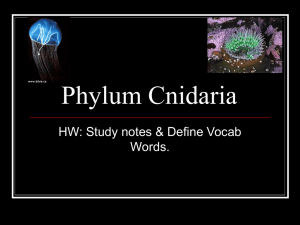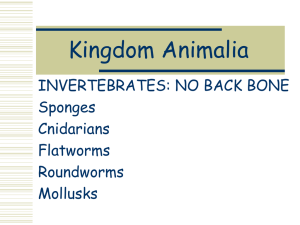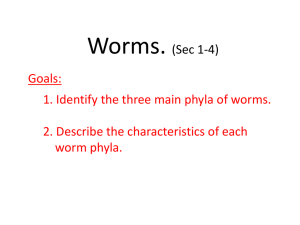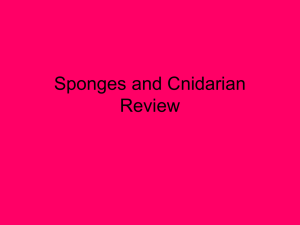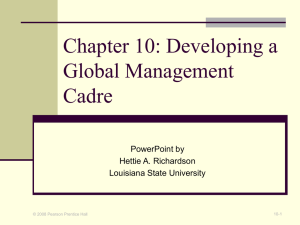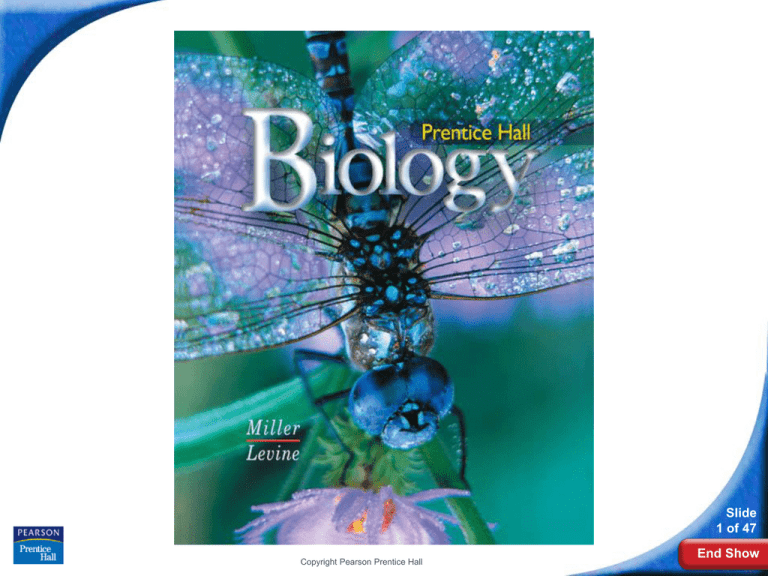
Biology
Slide
1 of 47
Copyright Pearson Prentice Hall
End Show
26-3 Cnidarians
Slide
2 of 47
Copyright Pearson Prentice Hall
End Show
26-3 Cnidarians
What is a Cnidarian?
What is a cnidarian?
Slide
3 of 47
Copyright Pearson Prentice Hall
End Show
26-3 Cnidarians
What is a Cnidarian?
What is a Cnidarian?
Cnidarians are soft-bodied, carnivorous
animals that have stinging tentacles
arranged in circles around their mouths.
They are the simplest animals to have
body symmetry and specialized tissues.
Slide
4 of 47
Copyright Pearson Prentice Hall
End Show
26-3 Cnidarians
What is a Cnidarian?
Cnidarians get their name from the
cnidocytes, or stinging cells, located along
their tentacles.
Cnidarians use cnidocytes for defense and to
capture prey.
Slide
5 of 47
Copyright Pearson Prentice Hall
End Show
26-3 Cnidarians
What is a Cnidarian?
Within each cnidocyte
is a nematocyst—a
poison-filled, stinging
structure that contains
a tightly coiled dart.
Trigger
Filament
Nematocyte
Barb
Filament
Slide
6 of 47
Copyright Pearson Prentice Hall
End Show
26-3 Cnidarians
What is a Cnidarian?
When a shrimp or small
fish brushes up against
the tentacles, thousands
of nematocysts explode,
releasing enough poison
to paralyze or kill the
prey.
Slide
7 of 47
Copyright Pearson Prentice Hall
End Show
26-3 Cnidarians
Form and Function in Cnidarians
What two body plans exist in the cnidarian
life cycle?
Slide
8 of 47
Copyright Pearson Prentice Hall
End Show
26-3 Cnidarians
Form and Function in Cnidarians
Form and Function in Cnidarians
Cnidarians are radially symmetrical. They have a
central mouth surrounded by numerous tentacles
that extend outward from the body.
Slide
9 of 47
Copyright Pearson Prentice Hall
End Show
26-3 Cnidarians
Form and Function in Cnidarians
Cnidarians typically have a life cycle that
includes two different-looking stages: a
polyp and a medusa.
Polyp
Copyright Pearson Prentice Hall
Medusa
Slide
10 of 47
End Show
26-3 Cnidarians
Form and Function in Cnidarians
A polyp is a cylindrical
body with armlike
tentacles. In a polyp, the
mouth points upward.
Polyps are usually
sessile.
Polyp
Slide
11 of 47
Copyright Pearson Prentice Hall
End Show
26-3 Cnidarians
Form and Function in Cnidarians
A medusa has a motile,
bell-shaped body with the
mouth on the bottom.
Medusa
Slide
12 of 47
Copyright Pearson Prentice Hall
End Show
26-3 Cnidarians
Form and Function in Cnidarians
Cnidarian polyps and medusas each have a body
wall that surrounds an internal space called a
gastrovascular cavity.
Gastrovascular
cavity
Gastrovascular
cavity
Slide
13 of 47
Copyright Pearson Prentice Hall
End Show
26-3 Cnidarians
Form and Function in Cnidarians
The gastroderm is the inner lining of the
gastrovascular cavity, where digestion takes place.
Gastrovascular cavity
Gastrovascular cavity
Slide
14 of 47
Copyright Pearson Prentice Hall
End Show
26-3 Cnidarians
Form and Function in Cnidarians
The epidermis is the outer layer of cells.
Epidermis
Epidermis
Slide
15 of 47
Copyright Pearson Prentice Hall
End Show
26-3 Cnidarians
Form and Function in Cnidarians
The mesoglea is a layer that lies between the
epidermis and gastroderm.
Mesoglea
Slide
16 of 47
Copyright Pearson Prentice Hall
End Show
26-3 Cnidarians
Form and Function in Cnidarians
Feeding
A cnidarian pulls its food through its mouth and into
its gastrovascular cavity, a digestive chamber
with one opening.
Food enters and wastes leave the body through
that same opening.
Slide
17 of 47
Copyright Pearson Prentice Hall
End Show
26-3 Cnidarians
Form and Function in Cnidarians
The digestion that occurs in the gastrovascular cavity
is extracellular, meaning that it takes place outside of
cells.
Partially digested food is absorbed by the
gastroderm.
Slide
18 of 47
Copyright Pearson Prentice Hall
End Show
26-3 Cnidarians
Form and Function in Cnidarians
Digestion is completed intracellularly, within cells in
the gastroderm.
Any materials that cannot be digested are passed out
of the body through the mouth.
Slide
19 of 47
Copyright Pearson Prentice Hall
End Show
26-3 Cnidarians
Form and Function in Cnidarians
Respiration, Circulation and Excretion
Following digestion, nutrients are usually
transported throughout the body by diffusion.
Cnidarians respire and eliminate the wastes of
cellular metabolism by diffusion through their body
walls.
Slide
20 of 47
Copyright Pearson Prentice Hall
End Show
26-3 Cnidarians
Form and Function in Cnidarians
Response
Cnidarians gather information from their
environment using specialized sensory cells.
Slide
21 of 47
Copyright Pearson Prentice Hall
End Show
26-3 Cnidarians
Form and Function in Cnidarians
Both polyps and medusas
have a nerve net, a
loosely organized
network of nerve cells.
Nerve cells
Slide
22 of 47
Copyright Pearson Prentice Hall
End Show
26-3 Cnidarians
Form and Function in Cnidarians
Cnidarians also have statocysts, which are groups of
sensory cells that help determine the direction of
gravity.
Ocelli are eyespots made of cells that detect light.
Slide
23 of 47
Copyright Pearson Prentice Hall
End Show
26-3 Cnidarians
Form and Function in Cnidarians
Movement
Sea anemones have a hydrostatic skeleton.
A hydrostatic skeleton consists of a layer of
circular muscles and a layer of longitudinal
muscles that, with the water in the gastrovascular
cavity, enable the cnidarian to move.
Slide
24 of 47
Copyright Pearson Prentice Hall
End Show
26-3 Cnidarians
Form and Function in Cnidarians
Reproduction
Most cnidarians reproduce both sexually and
asexually.
Polyps can reproduce asexually by budding.
In most cnidarians, sexual reproduction takes
place with external fertilization. External
fertilization takes place outside the female's body.
Slide
25 of 47
Copyright Pearson Prentice Hall
End Show
26-3 Cnidarians
Form and Function in Cnidarians
In the life cycle of Aurelia, a common jellyfish, the
female releases eggs into the water, and the male
releases sperm.
Slide
26 of 47
Copyright Pearson Prentice Hall
End Show
26-3 Cnidarians
Form and Function in Cnidarians
Fertilization occurs in open water.
Each zygote grows into a free-swimming
larva.
Slide
27 of 47
Copyright Pearson Prentice Hall
End Show
26-3 Cnidarians
Form and Function in Cnidarians
The larva eventually
attaches to a hard
surface and develops into
a polyp.
Slide
28 of 47
Copyright Pearson Prentice Hall
End Show
26-3 Cnidarians
Form and Function in Cnidarians
The polyp eventually
buds and releases young
medusas that begin the
cycle again.
Slide
29 of 47
Copyright Pearson Prentice Hall
End Show
26-3 Cnidarians
Groups of Cnidarians
What are the three groups of cnidarians?
Slide
30 of 47
Copyright Pearson Prentice Hall
End Show
26-3 Cnidarians
Groups of Cnidarians
Groups of Cnidarians
Cnidarians include:
• jellyfishes
• hydras and their relatives
• sea anemones and corals
Slide
31 of 47
Copyright Pearson Prentice Hall
End Show
26-3 Cnidarians
Groups of Cnidarians
Jellyfishes
The class Scyphozoa contains the jellyfishes.
Jellyfishes live their lives primarily as medusas.
The polyp form of jellyfishes is restricted to a small
larval stage, and no elaborate colonies ever form.
Jellyfishes reproduce sexually.
Slide
32 of 47
Copyright Pearson Prentice Hall
End Show
26-3 Cnidarians
Groups of Cnidarians
Hydras and Their Relatives
The class Hydrozoa contains hydras and related
animals.
The polyps of most hydrozoans grow in branching
colonies that can extend more than a meter.
Within the colony, polyps are specialized to
perform different functions.
Slide
33 of 47
Copyright Pearson Prentice Hall
End Show
26-3 Cnidarians
Groups of Cnidarians
The most common freshwater hydrozoans are
hydras.
Hydras differ from other cnidarians in this class
because they lack a medusa stage. Instead, they live
only as solitary polyps.
Hydras reproduce asexually, by budding, or sexually,
by producing eggs and sperm in the body wall.
Slide
34 of 47
Copyright Pearson Prentice Hall
End Show
26-3 Cnidarians
Groups of Cnidarians
Sea Anemones and Corals
The class Anthozoa contains sea anemones and
corals, animals that have only the polyp stage in
their life cycle.
Anthozoans all have a central body surrounded by
tentacles.
Slide
35 of 47
Copyright Pearson Prentice Hall
End Show
26-3 Cnidarians
Groups of Cnidarians
Many species are colonial, or composed of many
individual polyps.
Sea anemones are solitary polyps that live at all
depths of the ocean.
Slide
36 of 47
Copyright Pearson Prentice Hall
End Show
26-3 Cnidarians
Groups of Cnidarians
Most corals are colonial, and their polyps grow
together in large numbers.
New polyps are produced by budding, and as the
colonies grow, they secrete an underlying skeleton of
calcium carbonate, or limestone.
Slide
37 of 47
Copyright Pearson Prentice Hall
End Show
26-3 Cnidarians
Ecology of Corals
Ecology of Corals
Worldwide distribution of corals is determined by a
few variables:
• temperature
• water depth
• light intensity
Slide
38 of 47
Copyright Pearson Prentice Hall
End Show
26-3 Cnidarians
Ecology of Corals
The corals that build coral reefs require high levels of
light—these corals rely on algae that capture solar
energy, recycle nutrients, and help corals lay down
their calcium carbonate skeletons.
Slide
39 of 47
Copyright Pearson Prentice Hall
End Show
26-3 Cnidarians
Ecology of Corals
Symbionts provide as much as 60 percent of the
energy corals need. This allows coral reefs to live in
water that carries few nutrients.
Slide
40 of 47
Copyright Pearson Prentice Hall
End Show
26-3 Cnidarians
Ecology of Corals
Many coral reefs suffer from human activity:
•
Silt and sediments from logging, farming, mining,
and construction smother corals.
•
Chemical fertilizers, insecticides, and industrial
pollutants poison corals.
•
Overfishing upsets ecological balance.
•
Stresses that makes coral reefs susceptible to
other threats.
Slide
41 of 47
Copyright Pearson Prentice Hall
End Show
26-3
Click to Launch:
Continue to:
- or -
Slide
42 of 47
End Show
Copyright Pearson Prentice Hall
26-3
The characteristic that defines the cnidarians is
a. bilateral symmetry.
b. stinging cells.
c. a gastrovascular cavity.
d. cephalization.
Slide
43 of 47
End Show
Copyright Pearson Prentice Hall
26-3
Which of the following statements is generally
true of polyps and medusas?
a. Polyps are sessile, and medusas are motile.
b. Polyps are motile, and medusas are sessile
c. Both polyps and medusas are sessile.
d. Both polyps and medusas are motile.
Slide
44 of 47
End Show
Copyright Pearson Prentice Hall
26-3
During the life cycle of Aurelia, the zygote grows
into a free-swimming
a. polyp.
b. larva.
c. medusa.
d. gemmule.
Slide
45 of 47
End Show
Copyright Pearson Prentice Hall
26-3
Cnidarians, such as the sea anemone, move
using
a. water currents.
b. an exoskeleton.
c. a hydrostatic skeleton.
d. an endoskeleton.
Slide
46 of 47
End Show
Copyright Pearson Prentice Hall
26-3
Groups of sensory cells that help cnidarians
determine the direction of gravity are known as
a. nerve nets.
b. statocysts.
c. ocelli.
d. cnidocytes.
Slide
47 of 47
End Show
Copyright Pearson Prentice Hall
END OF SECTION

